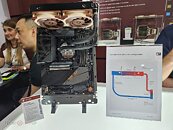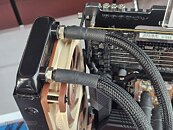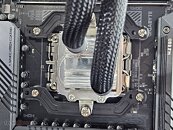- Joined
- May 21, 2024
- Messages
- 1,144 (3.48/day)
Noctua, known for air cooling solutions, revealed a prototype for a "liquid" cooling product at Computex. However, this "liquid" cooler has no pump, Noctua's design aims to provide effective cooling without it. We got the chance to see it during our visit to the Noctua Computex booth, and we can say that even in its early prototype stage, it looks good.
Instead of a traditional pump, Noctua's design uses a two-phase thermosiphon. This technology works by heating a fluid, causing it to evaporate and circulate through density differences. The evaporated fluid moves through a vapor tube to a condenser, where it cools down and returns to liquid form. The liquid then flows back to the evaporator, and the cycle repeats.





This process is similar to how a heatpipe functions, which Noctua has expertise in. Noctua collaborated with an aviation cooling company called Calyos on this thermosiphon project, the phase change process allows for absorbing a lot of heat before vaporization, making it suitable for cooling power-hungry CPUs.
The goal is to achieve performance comparable to an all-in-one (AIO) liquid cooler without the drawbacks, such as pump noise, vibration, or failure risk. However, the thermosiphon relies on gravity, so the radiator (240 mm or 360 mm) must be top-mounted in the chassis. While fans are still attached to the radiator in the prototype, it eliminates the need for a pump.
For the moment, according to Noctua, this is a long-term project in the early development stage, with no ETA or pricing being made.
View at TechPowerUp Main Site
Instead of a traditional pump, Noctua's design uses a two-phase thermosiphon. This technology works by heating a fluid, causing it to evaporate and circulate through density differences. The evaporated fluid moves through a vapor tube to a condenser, where it cools down and returns to liquid form. The liquid then flows back to the evaporator, and the cycle repeats.





This process is similar to how a heatpipe functions, which Noctua has expertise in. Noctua collaborated with an aviation cooling company called Calyos on this thermosiphon project, the phase change process allows for absorbing a lot of heat before vaporization, making it suitable for cooling power-hungry CPUs.
The goal is to achieve performance comparable to an all-in-one (AIO) liquid cooler without the drawbacks, such as pump noise, vibration, or failure risk. However, the thermosiphon relies on gravity, so the radiator (240 mm or 360 mm) must be top-mounted in the chassis. While fans are still attached to the radiator in the prototype, it eliminates the need for a pump.
For the moment, according to Noctua, this is a long-term project in the early development stage, with no ETA or pricing being made.
View at TechPowerUp Main Site




